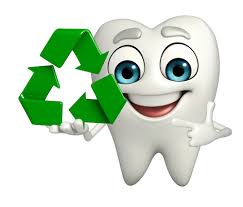
For most of us, brushing our teeth is something we do on autopilot. We get up in the morning and brush our teeth — and then do it again as the last thing we do before going to bed.
Most of our toothpastes are a mashup of artificial ingredients, though. While they do get the job done, they aren’t the greenest option out there and can be harsh on sensitive teeth. How can dental practices — and those of us concerned about our dental hygiene at home — be a little bit greener and eco-friendlier?
Switching to Organic Toothpaste
Toothpaste is a relatively new invention. Until the early 1900s, brushing your teeth twice a day was unheard of. Most people didn’t brush their teeth at all, which was leading to an epidemic of dental disease across the country — until an inventor and an advertiser got together and created a market for a new toothpaste called Pepsodent.
This created a nationwide tooth-brushing habit that carries through to this day, reducing the prevalence of dental disease and making billions of dollars in the process. In just 10 years, the number of people who brushed their teeth daily increased from 7% to 65%!
Today, though, most toothpaste formulas include artificial ingredients and sweeteners like sorbitol, calcium carbonate and sodium lauryl sulfate, in addition to fluoride. Switching to an organic toothpaste that uses things like coconut oil, baking soda, sea salt or charcoal can help make the whole tooth-brushing process a bit greener, because you won’t be washing all those artificial chemicals down the drain.
Eliminating PCBs
You know that smell you notice when you walk into a doctor’s office or another medical facility? It’s synonymous with these facilities — as soon as you smell it, you know there are doctors or dentists nearby. It’s also not the best thing for you. This iconic hospital smell is the result of persistent bio-accumulative-toxins , chemicals that get aerosolized through various processes and remain present in the air.
Dentists’ offices can go greener by pledging to eliminate these chemicals from the air by switching to greener methods or improving office ventilation.
Reducing the Use of Metals
Dental practices have used metals like gold and mercury for decades, for fillings, caps and crowns. Another way to reduce an office’s carbon footprint is to reduce the use of these metals.
Only 1 percent of the world’s gold supply gets used in the dental industry, but the conditions surrounding the excavation of this metal are poor, both for the environment and for the people working in the mine. Mercury is a component of fillings, but it can be unhealthy for both the patient and for the environment if the mercury leaks into the local water supply and the surrounding ecosystem. One study has even suggested modern dental fillings release more mercury, in the form of mercury vapor, than older formulas have done in the past.
Porcelain caps and crowns can replace both of these materials, and dentists can opt to use glass ionomer instead of mercury amalgams for fillings. For older amalgams that need to come out, an amalgam separator can remove the mercury for safe disposal.
Going Paperless
As with most medical professions, there is a lot of paper surrounding the dentistry industry. Patient files, post-visit instructions, bills and prescriptions all get printed on paper, but dental offices could replace many of these completely with digital alternatives.
Committing to go paperless might take some time, but it can reduce the overall carbon footprint of the office by reducing the amount of paper it uses. For anything that can’t be digitized, using 100 percent recycled paper can help offset the damage a little bit.
Using Energy Star Equipment
A lot of equipment in the average dentist’s office runs on electricity — from the dental drill to the X-ray machine and even the computers that store patient files. Replacing old or outdated equipment with Energy Star-rated alternatives can help reduce the office’s overall energy consumption. It also reduces the carbon footprint of the office by using less energy from fossil fuels.
Depending on the location, some offices may even want to consider going solar, or at least adding a few solar panels to the facility to offset energy costs.
It might not seem like much, but even taking one little step to choose an eco-friendly dentist’s office or an organic toothpaste can do a lot. In addition to reducing your carbon footprint, it can also cause a fundamental shift in the way you and others around you think. If we can get enough people to experience that shift toward eco-friendly thinking, we might be able to make a substantial change.
Matter referenced:
Kate Harveston,
By: Dr. Bhawana Asnani.
Happy to see Reviews, Additions, Suggestions and Comments, further.

Leave a Reply
You must be logged in to post a comment.